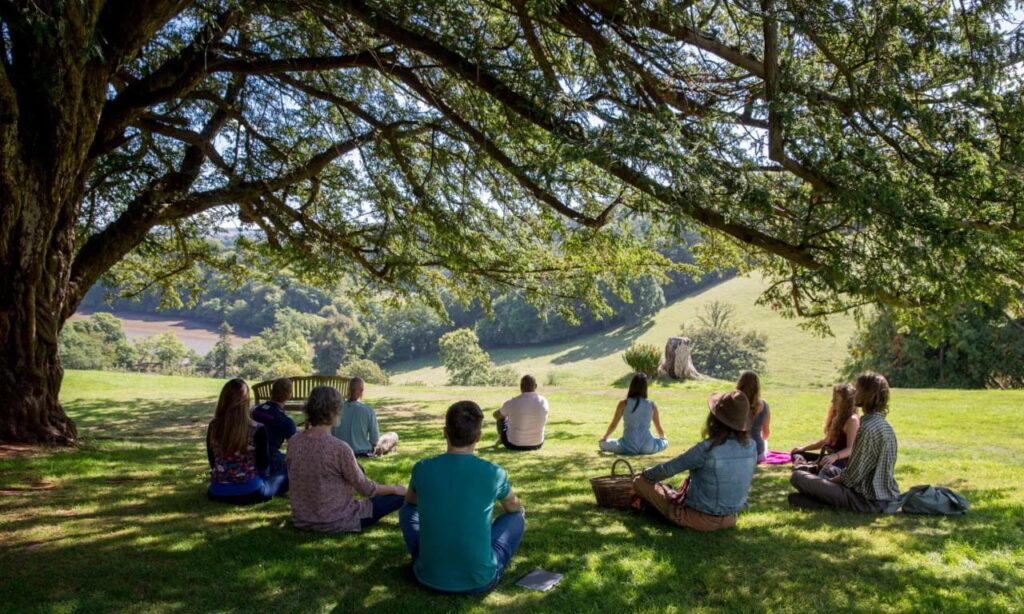In an increasingly digitized and demanding world, the profound benefits of connecting with nature have never been more critical. Nature’s embrace offers a unique and powerful pathway to physical, mental, and spiritual rejuvenation, providing an unparalleled opportunity to recharge and thrive. This extensive article delves into the myriad ways immersion in the natural world can transform your well-being, offering practical strategies for seeking out green spaces, mindfully engaging with the environment, and integrating the restorative power of nature into your daily life. Prepare to discover your ultimate sanctuary for renewal.
The Irresistible Call of Nature

What is it about natural environments that so profoundly impacts our sense of well-being? The connection between humans and nature is not merely aesthetic; it’s deeply rooted in our biology and psychology.
A. Restoring Mental Clarity and Reducing Stress: Exposure to natural environments has been scientifically proven to lower cortisol levels, reduce blood pressure, and decrease feelings of anxiety and depression. The gentle rhythms of nature provide a calming contrast to the overstimulation of urban life, allowing our minds to rest and reset. This leads to improved focus and a clearer mental state.
B. Boosting Mood and Enhancing Happiness: Spending time in nature can significantly elevate mood. Sunlight exposure increases Vitamin D production, which is linked to mood regulation. The vibrant colors, fresh air, and serene sounds of natural settings trigger positive emotional responses, fostering feelings of joy, peace, and contentment. Many studies point to an increase in feelings of awe and wonder.
C. Improving Physical Health and Vitality: Engaging with nature often involves physical activity, from gentle walks to vigorous hikes, which benefits cardiovascular health, strengthens muscles, and improves overall fitness. Fresh air, free from urban pollutants, and exposure to natural light contribute to better respiratory health and regulated sleep cycles.
D. Stimulating Creativity and Problem-Solving: A break from routine and the stimulation of natural surroundings can spark new ideas and enhance cognitive flexibility. When our minds are not overwhelmed by external demands, they are free to wander, connect disparate concepts, and generate innovative solutions.
E. Fostering a Deeper Sense of Connection and Purpose: Immersing ourselves in nature often evokes a sense of humility and interconnectedness with the larger world. This can lead to profound self-reflection, a clearer understanding of our place in the ecosystem, and a renewed sense of purpose and appreciation for life.
F. Enhancing Sensory Experience: Nature engages all our senses in a harmonious way. The scent of pine, the sound of rustling leaves or flowing water, the sight of vibrant flora and fauna, and the feel of wind on our skin provide a rich, multi-sensory experience that is often dulled by indoor or urban environments.
Diverse Forms of Nature’s Embrace
“Nature’s embrace” is not limited to grand national parks. It exists in countless forms, accessible in various ways, allowing everyone to find their ideal spot for rejuvenation.
A. Wilderness Escapes: Deep Immersion: For those seeking profound disconnection and raw beauty.
1. National and State Parks: Vast protected areas offering extensive hiking trails, camping, wildlife viewing, and opportunities for multi-day backcountry trips. These provide truly immersive experiences away from civilization.
2. Remote Forests and Mountains: Venturing into less-traveled natural areas for challenging treks, mountaineering, or serene solitude. These often require more planning and self-sufficiency.
3. Coastal and Marine Environments: Exploring untouched beaches, diving in vibrant coral reefs, or sailing tranquil waters. These offer unique sensory experiences and opportunities for marine wildlife observation.
B. Urban Green Spaces: Accessible Oases: Even in bustling cities, nature’s embrace can be found.
1. City Parks and Gardens: Local parks, botanical gardens, and arboretums offer immediate access to greenery, walking paths, and quiet spots for reflection, providing vital breaks from urban concrete.
2. Riverside Paths and Greenways: Many cities have developed walking and cycling paths along rivers, canals, or old railway lines, providing linear green corridors for recreation and connection with nature.
3. Community Gardens and Rooftop Gardens: Small, localized pockets of nature that offer a sense of community, the joy of cultivation, and a touch of greenery in dense urban areas.
C. Specialized Nature Retreats: Focused Rejuvenation:
1. Forest Bathing (Shinrin-Yoku) Retreats: Guided experiences focused on slow, mindful immersion in forests, emphasizing sensory awareness and connection with trees.
2. Yoga and Meditation Retreats in Nature: Combining physical and mental practices with serene natural settings to enhance relaxation, mindfulness, and inner peace.
3. Eco-Lodges and Wilderness Resorts: Accommodation specifically designed to blend seamlessly with natural surroundings, offering comfort while prioritizing environmental sustainability and direct access to nature.
D. Backyard and Home-Based Nature: Daily Doses of Green: You don’t always need to travel far.
1. Personal Gardens: Cultivating your own garden, no matter how small (even a balcony garden), provides daily interaction with plants, soil, and the growth cycle.
2. Houseplants: Bringing greenery indoors can improve air quality, reduce stress, and provide a visual connection to nature.
3. Mindful Window Views: Simply taking a moment to observe trees, sky, or clouds from your window can be a mini-recharge, especially for those with limited outdoor access.
Strategies for Mindful Nature Immersion

It’s not just about being in nature; it’s about being with nature. Mindful engagement amplifies the restorative benefits.
A. Practice Mindful Walking:
1. Engage All Senses: Instead of focusing on destination, pay attention to the sensation of your feet on the ground, the sound of your breath, the rustle of leaves, the scent of damp earth, and the colors of the flora.
2. Slow Down: Walk at a leisurely pace, allowing yourself to observe details you might otherwise miss.
3. Leave Technology Behind: Resist the urge to constantly check your phone. Allow yourself to be fully present without digital distractions.
B. Embrace Forest Bathing (Shinrin-Yoku) Principles:
1. Find a Quiet Spot: Seek out a peaceful area in a forest or park.
2. Open Your Senses: Deliberately notice the textures of bark, the varied greens of leaves, the songs of birds, and the earthy aromas.
3. Sit and Observe: Find a comfortable spot to sit quietly for a period, simply observing the natural world around you without agenda.
4. Deep Breathing: Take slow, deep breaths, inhaling the fresh air and exhaling any tension.
C. Engage in Grounding (Earthing):
1. Barefoot Contact: Walk barefoot on grass, sand, or soil. This direct skin contact with the Earth is believed by some to have therapeutic benefits by connecting with the Earth’s electrical energy.
2. Lie on the Earth: Simply lie down on a patch of grass or a beach and feel the direct connection to the ground.
D. Mindful Observation of Specific Elements:
1. Cloud Gazing: Lie back and watch the clouds drift and transform.
2. Bird Watching: Focus on identifying different bird calls or observing their behaviors.
3. Plant Study: Take time to examine the intricate details of a single leaf, a flower, or a patch of moss.
E. Creative Expression in Nature:
1. Nature Journaling: Write or sketch about your observations, feelings, and thoughts inspired by your natural surroundings.
2. Nature Photography: Focus on capturing the beauty and details of nature, which encourages careful observation.
3. Art with Natural Materials: Create temporary art using leaves, stones, twigs, and other natural elements.
F. Embrace Silence and Stillness:
1. Listen to Nature’s Sounds: Pay attention to the wind, the water, the birds, and other sounds that often go unnoticed in busy environments.
2. Meditate Outdoors: Find a peaceful spot and practice meditation, using the sounds of nature as your focal point.
Overcoming Barriers to Nature’s Embrace
Despite its undeniable benefits, accessing and fully engaging with nature can sometimes present challenges.
A. Time Constraints and Busy Schedules:
1. Micro-Doses of Nature: Even 5-10 minutes of mindful time in a nearby park, backyard, or even looking out a window can offer benefits.
2. Integrate Nature into Routine: Walk or cycle to work through a park, take lunch breaks outside, or exercise outdoors.
B. Lack of Accessible Green Spaces:
1. Explore Local Options: Research community gardens, smaller urban parks, or even tree-lined streets in your neighborhood.
2. Indoor Nature: Bring houseplants into your home or workplace. Look for nature documentaries or virtual reality experiences that simulate nature.
3. Weekend Escapes: Plan short trips to larger natural areas if daily access is limited.
C. Weather Conditions:
1. Dress Appropriately: Invest in good rain gear or warm layers to allow for outdoor time in various conditions.
2. Embrace All Seasons: Each season offers unique beauty and experiences. A snowy walk or a rainy forest can be equally restorative.
3. Indoor Alternatives: On extreme weather days, focus on indoor nature connections like looking at nature photography, listening to nature soundscapes, or caring for houseplants.
D. Digital Distractions and Habitual Connectivity:
1. Intentional “Tech-Free” Zones: Designate specific times or places (e.g., during a nature walk) as phone-free.
2. Leave Devices Behind: If safe, leave your phone at home or in the car during short nature excursions.
3. Turn Off Notifications: Minimize interruptions when you are trying to be present in nature.
E. Fear of Insects, Wildlife, or Unfamiliar Environments:
1. Start Small: Begin with familiar, well-maintained parks before venturing into more wild areas.
2. Educate Yourself: Learn about local flora and fauna to demystify them. Understand basic safety precautions.
3. Go with a Companion: Exploring with a friend can increase comfort and safety.
Integrating Nature’s Wisdom
The benefits of nature’s embrace shouldn’t end when you leave the park or forest. Integrating these experiences into your daily life sustains the recharge.
A. Reflect on Your Nature Experiences:
1. Journaling: Write about your feelings, observations, and insights gained during your time in nature. How did it make you feel? What did you notice?
2. Share Your Stories: Talk about your experiences with friends and family, inspiring them to connect with nature too.
3. Review Photos/Videos: Look back at images to relive moments and reinforce positive emotions.
B. Bring Nature Indoors:
1. Houseplants and Greenery: Incorporate more plants into your home and workspace.
2. Natural Light: Maximize natural light in your living and working spaces.
3. Nature-Inspired Decor: Use natural materials, colors, and imagery (e.g., landscape art) in your interior design.
4. Nature Sounds/Scents: Play natural soundscapes or use essential oils with earthy or floral scents.
C. Make Nature a Consistent Part of Your Routine:
1. Daily Walks: Commit to a daily walk in a nearby park or green space.
2. Outdoor Breaks: Take your coffee breaks, lunch breaks, or short work breaks outdoors.
3. Weekend Adventures: Plan regular excursions to larger natural areas or engaging in outdoor hobbies.
4. Community Involvement: Join a local hiking group, gardening club, or conservation volunteer group.
D. Advocate for Green Spaces and Conservation:
1. Support Local Parks: Get involved in local park clean-up efforts or advocacy groups.
2. Environmental Education: Learn more about conservation and sustainable practices.
3. Reduce Your Footprint: Live more sustainably to protect the natural environments that provide so much benefit.
E. Cultivate a Mindset of Appreciation for Nature:
1. Practice Gratitude: Regularly acknowledge the beauty and restorative power of the natural world.
2. Observe from Afar: Even when stuck indoors, take moments to observe the sky, the weather, or the plants outside your window.
3. Teach Others: Share the importance of nature connection with children and those around you.
Conclusion
In a world that constantly pulls us outward, the simple, profound act of connecting with nature’s embrace offers an unparalleled opportunity to recharge and thrive. It’s not a luxury, but a fundamental human need that revitalizes our bodies, calms our minds, and nourishes our souls. By intentionally seeking out green spaces, mindfully engaging with the environment, and integrating its restorative power into your daily rhythm, you unlock a continuous wellspring of well-being. So, step outside, breathe deeply, and allow the ancient wisdom of the natural world to remind you of your own inherent capacity for renewal. Your journey to enduring vitality starts with a single step into the green.







